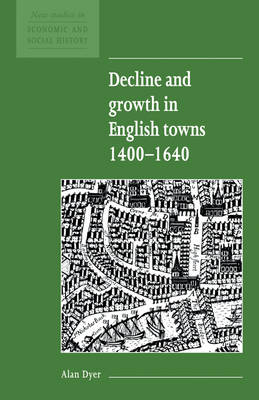
Decline and Growth in English Towns 1400–1640
Seiten
1995
Cambridge University Press (Verlag)
978-0-521-55781-8 (ISBN)
Cambridge University Press (Verlag)
978-0-521-55781-8 (ISBN)
Historians have long disputed whether English towns were in decline in the period 1400–1640. This book reviews the literature of the controversy, guides the reader through it, and adds new insights derived from the author's own research. This is a book both for students beginning the study of the subject and for their teachers.
Although historians have always studied towns, widespread interest in urban history as a specialised historical field is relatively recent. This fashion has stimulated the development of a major controversy about the fortunes of towns in England between the fourteenth and seventeenth centuries. Some see them as prone to crisis and frequently subject to decay, while others have held that many of them prospered in these centuries. This book guides the reader through the controversy, summarises the opposing arguments, and adds new insights derived from the author's own research. Alan Dyer argues that the problem lay in the rise and decline of regional economies rather than the rise and decline of the towns which lay in those regions. An extensive bibliography with notes helps the reader to come to his or her own conclusions.
Although historians have always studied towns, widespread interest in urban history as a specialised historical field is relatively recent. This fashion has stimulated the development of a major controversy about the fortunes of towns in England between the fourteenth and seventeenth centuries. Some see them as prone to crisis and frequently subject to decay, while others have held that many of them prospered in these centuries. This book guides the reader through the controversy, summarises the opposing arguments, and adds new insights derived from the author's own research. Alan Dyer argues that the problem lay in the rise and decline of regional economies rather than the rise and decline of the towns which lay in those regions. An extensive bibliography with notes helps the reader to come to his or her own conclusions.
List of maps; Note on references; Acknowledgement; 1. Introduction; 2. The background to the controversy; 3. Urban fortunes before 1450; 4. Urban crisis at the end of the middle ages; 5. The problems of evidence; 6. Expansion and decline 1540–1640; 7. Conclusion; Appendices; Select Bibliography; Index.
| Erscheint lt. Verlag | 14.9.1995 |
|---|---|
| Reihe/Serie | New Studies in Economic and Social History |
| Zusatzinfo | 5 Tables, unspecified |
| Verlagsort | Cambridge |
| Sprache | englisch |
| Maße | 140 x 216 mm |
| Gewicht | 130 g |
| Themenwelt | Geisteswissenschaften ► Geschichte ► Regional- / Ländergeschichte |
| Geschichte ► Teilgebiete der Geschichte ► Kulturgeschichte | |
| Geschichte ► Teilgebiete der Geschichte ► Sozialgeschichte | |
| ISBN-10 | 0-521-55781-X / 052155781X |
| ISBN-13 | 978-0-521-55781-8 / 9780521557818 |
| Zustand | Neuware |
| Haben Sie eine Frage zum Produkt? |
Mehr entdecken
aus dem Bereich
aus dem Bereich
der stille Abschied vom bäuerlichen Leben in Deutschland
Buch | Hardcover (2023)
C.H.Beck (Verlag)
23,00 €
vom Mittelalter bis zur Gegenwart
Buch | Softcover (2024)
C.H.Beck (Verlag)
12,00 €
eine Geschichte der Welt in 99 Obsessionen
Buch | Hardcover (2023)
Klett-Cotta (Verlag)
22,00 €


